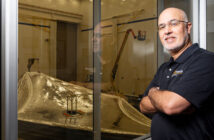The department of earth and environmental sciences hosted Dr. Ellyn Enderlin, ’08, on Friday to speak about her post-doctorate research on the change in mass of glaciers in Greenland.
The presentation was entitled “Glaciers Gone Wild: Rapid Change in Greenland Glacier Behavior Initiated at Ocean’s Edge.” It was a part of the undergraduate research symposium that took place on the same day.
Enderlin graduated from Lehigh with a degree in environmental science and continued her studies at the Ohio State University, where she completed an M.S. in geological sciences and a Ph.D. in earth sciences.
Enderlin’s research in Greenland has consisted of measuring the marine glaciers’ change in mass, as well as making estimates of the change.
“Temporal gaps in glacier speed and thickness observations has increased the amount of uncertainty,” Enderlin said.
The importance of the speed and thickness of a glacier is that these factors affect the way the glacier melts and what the result of the melting is, she said.
For instance, Enderlin studies whether glaciers will descend into shallow water or whether they will descend into deep water, which has higher water pressure and therefore expedites the melting process.
“There are a lot of gaps in our understanding of glaciers,” she said. Limited observation of ice, ocean, atmosphere and bedrock boundaries have slowed progress in the field.
“We need to improve our understanding and competence and analyze time series of glacier dynamics,” Enderlin said.
Runoff from melting has increased significantly since the 1990s, which has greatly increased the cumulative mass loss of glaciers. Enderlin said approximately 3,000 gigatons of glaciers have been lost, which has brought about an eight millimeter increase in sea level.
Submarine melting has contributed to a sizable amount of mass loss due to the intersection of the glacier ice and warmer ocean water. Measuring submarine melting is both difficult and dangerous, as the two most common methods for collecting data are expensive and incur a great deal of uncertainty, Enderlin said.
Lidar, which Enderlin likened to a laser pointer that measures distance, can pick up on numerous icebergs in water, which creates room for error.
The other measurement method involves a costly raft-like apparatus that travels to the base of the glaciers, allowing data collection to be done.
“(But) because the glaciers break apart, it’s really unsafe,” Enderlin said.
Enderlin closed her presentation with a five part take-away: Glaciers dynamically accelerate and thin in response to changes in their stress balance; changes in Greenland’s ice discharge is driven by about five main glaciers; changes in Greenland’s ice sheet mass loss have been due to changes in mass loss, not to glacial discharge; increased submarine melting may trigger dynamic glacial loss; and melt rates can be used to estimate changes in tidewater glacial melting.
Many earth and environmental sciences undergraduates were in attendance at the seminar.
“It was good to see a successful Lehigh alum environmental science major,” said Chris Geist,’14.
Cody Raup, ’14, agreed.
“It was a unique talk because it gave us something to aspire to as students,” he said.





Comment policy
Comments posted to The Brown and White website are reviewed by a moderator before being approved. Incendiary speech or harassing language, including comments targeted at individuals, may be deemed unacceptable and not published. Spam and other soliciting will also be declined.
The Brown and White also reserves the right to not publish entirely anonymous comments.